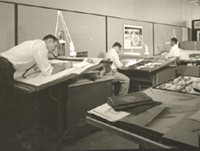
A History of Scholarship on American Automobile Design
Scholarly Inattention to Auto Design
Despite its long-recognized centrality to consumer decisions, however, auto aesthetics has received surprisingly sparse attention from scholars. Hundreds of scholarly books and articles have been written on automobile production, technology, workers, labor relations, safety, marketing, management, and environmental impact, but only a handful have treated the design of the auto’s appearance. Of course, the popular automotive press produces a constant stream of books and magazines documenting the twists and turns of the automobile styles of the past, present, and future. But serious scholars have studiously avoided the topic. What accounts for this inattention to the design of the material artifact that has been at the center of America’s popular culture for almost a century? Surely, it is the cultural preferences and prejudices of intellectuals themselves. As sociologist Pierre Bourdieu has demonstrated, cultural tastes are determined by social class, and the class of people who make their living by creating and transmitting knowledge generally prefer high culture over popular culture. In other words, intellectuals prefer culture that is focused on pure form and aesthetics--art for art’s sake--not culture that is useful, even if only for giving immediate pleasure. Clearly, automobile design falls into the latter category, which defines popular culture. Cars are designed not as art objects in themselves but for other, external purposes: to accommodate mechanical parts, to reduce wind resistance and save gas, to hold passengers and cargo, to please consumers’ eyes and egos, and, above all, to increase sales and make money. For intellectuals, the focus of auto aesthetics on market sales is particularly damning, for they like to see themselves and their work as above the crass concern for cash. Consequently, they have consciously avoided paying serious attention to this popular art that affects every American’s life.
For years, then, interest in American auto design was confined to the popular press and the special literature for automobile enthusiasts. Most of the books and articles from these sources were focused on and fetishized the end product of design, often elevating particular cars and brands to the level of cult objects, around which quasi-religious devotion developed. Little attention was paid to the actual process of design or designers themselves, for to conceive of these cars as the products of human endeavor threatened to break the aura of the automotive fetish. Likewise, there was little tolerance for any analysis that attempted to place design in a broader historical or social context, seeing it as the product of particular societies and times. Finally, most of this popular literature was wholly uncritical of automobiles and the industry that produced them. Not surprisingly, journalists on the automotive beat were usually enthusiasts themselves, and developed close and amiable ties with the industry about which they wrote. So although there was sometimes mild criticism for the technical and aesthetic failings of particular cars, there was little enthusiasm for a detached, critical perspective on the automobile in general and its industry, or their relation to American society as a whole.
<<Previous Section - Next Section>>
Introduction
Drafting
©2004 Automobile in American Life and Society